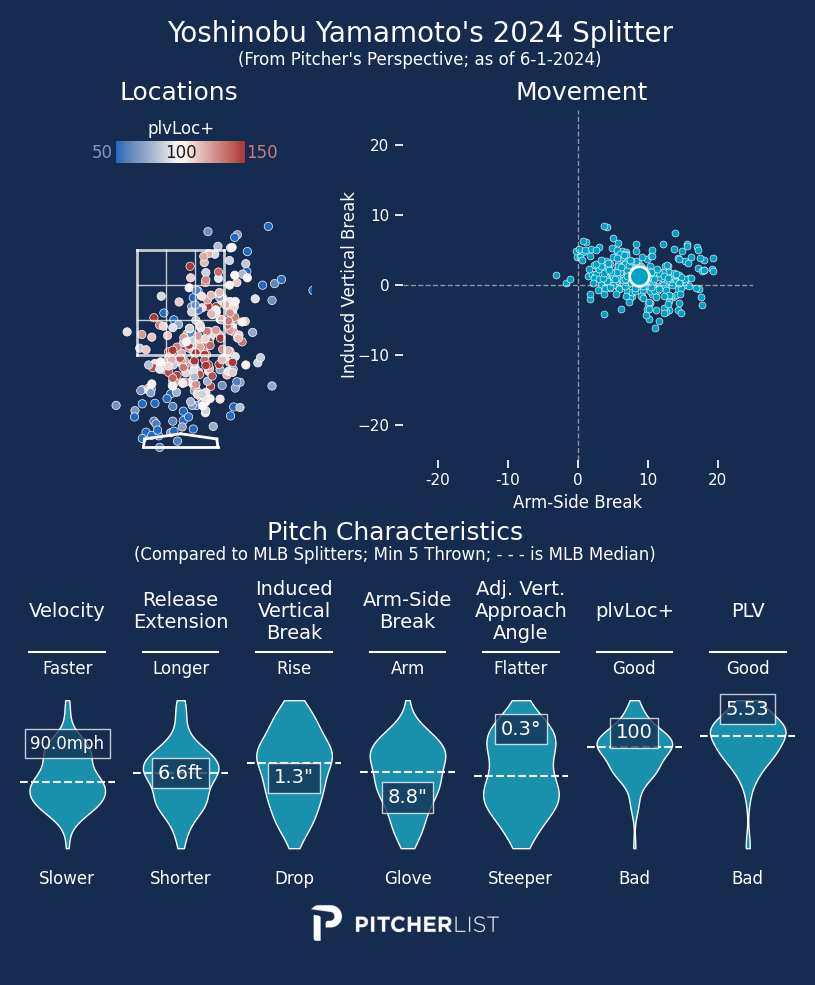We’re back with another week of the PLV report. This series will use the PLV metrics to contextualize player performance, and this week we’ll use our PLV model (Nick’s primer on PLV from last year can be found here) to identify the best pitches through the first 1/3rd of the season. We now have a decent enough sample of starters who have thrown 500+ pitches (around when PLV stabilizes), and we’ll be limiting our search to pitches that are in the Top 25% of number thrown for that pitch type. The Pitch Type cards have a plvLocation+ score shown, which is modelled similarly to PLV, but only uses the end locations of the pitch (horizontal, vertical, and location within the specific hitter’s strike zone) as inputs.
Note: PLV metrics listed are current through Monday, June 3rd.
Four-Seamer – Shōta Imanaga
This shouldn’t be a surprise, as Imanaga and his fastball were featured last month in this series. We highlighted how the pitch is incredible, even with subpar velocity, and nothing has really changed since then. Our sample of pitches has gone up, and Imanaga is still shoving, thanks to that elite 4-Seam.
Imanaga gets elite IVB from a relatively low arm angle, which also allows him to create a very flat Vertical Approach Angle (especially after you control for pitch location). He does a great job of keeping the pitch up in the zone, specifically in that shadow zone right around the edge of the strike zone. He doesn’t miss by a lot on the off chance that he isn’t throwing it for strikes, and he certainly doesn’t throw meatballs (only a 2% Mistake Rate and 89th percentile middle-middle Loc%). He doesn’t get as many called strikes as you’d hope (13.5 CStr%), especially given his very high Zone% (55.4%; 73rd percentile).
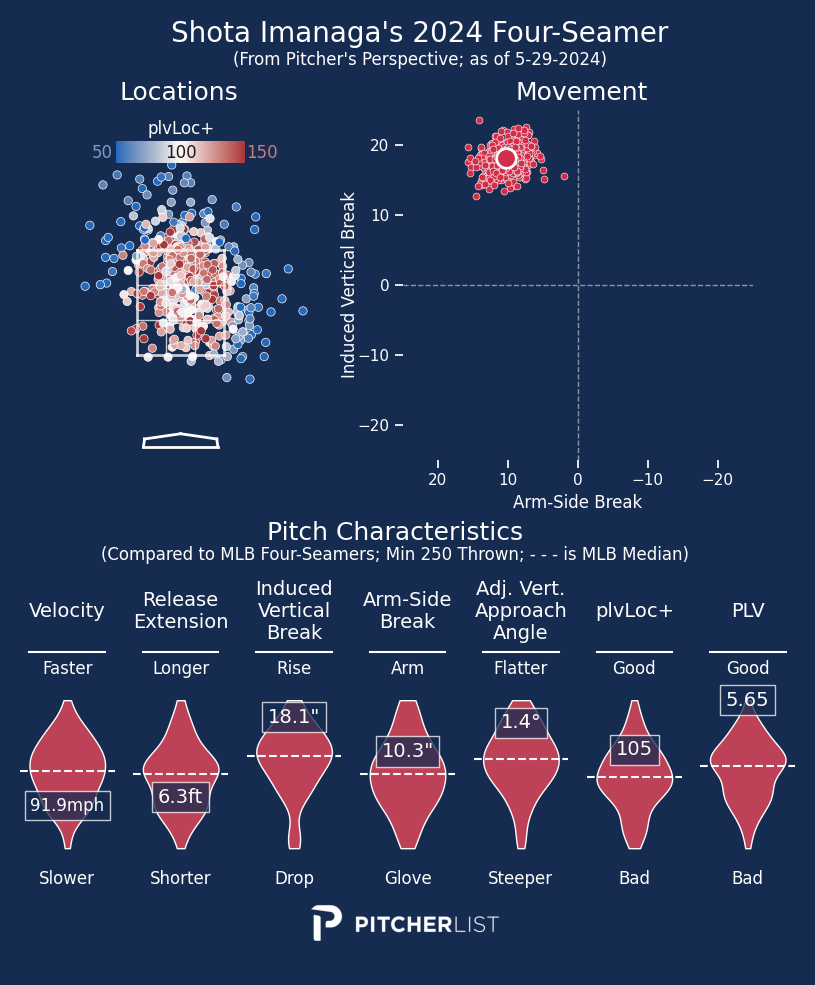
Imanaga is proof that pure speed isn’t the only thing that matters, as this has arguably been the best pitch in baseball so far, and it’s a foundational piece for one of the most impressive pitchers in the league.
Slider – Tanner Houck
The Slider is Houck’s weapon of choice, and it is easy to see why. It’s the sweepiest (totally a word) non-Sweeper in our database, and he locates it in the zone a shocking 57.1% of the time (95th percentile). The locations explain the elite 24.7 CStr% (93rd percentile) and the huge break explains the relative lack of whiffs (40th percentile SwStr%; Sweepers are very effective at limiting contact, but don’t have quite the whiffability of harder gyro Sliders).
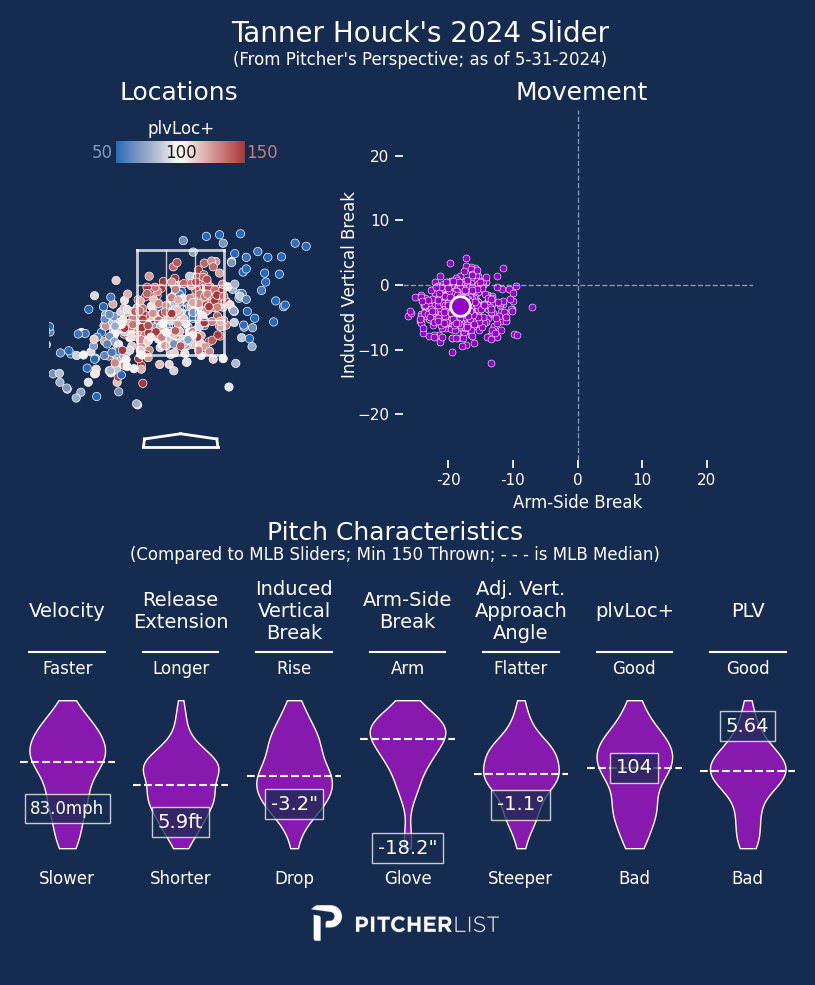
That huge break from Houck’s low arm slot has given hitters fits, as they can’t quite square the pitch up (.293 xBABIP vs .332 xwOBACON). The Slider plays well off of Houck’s surprisingly useful Sinker, which also has outlier movement (17.5″ of glove-side break) and solid velocity (93.3mph). That gives Houck a ridiculous 37.5″ of horizontal break difference between his two primary pitches, in addition to a 10 mph velocity difference. Good luck trying to get a barrel on that.
Sinker – Ranger Suárez
Ranger Suárez has been having a dream of a season, with a 1.70 ERA, 0.80 WHIP, and 28.5 K%. I fully expect him to come back to Earth a bit, but the quality of his Sinker will allow for a gentler descent, rather than a crash.
Suárez does an incredible job of locating the pitch, with an elite 108 plvLocation+, and you can see on the Pitch Card that he keeps nearly all of his pitches close to the zone. He generally avoids the heart of the plate, which is important for him, as he doesn’t have a lot of room for error if he misses there (10.2% Mistake Rate). All this combines for expertly placed pitches in locations where the hitter has to make a tough swing decision (and they’ve frequently decided incorrectly, with a 27.4 CStr%).
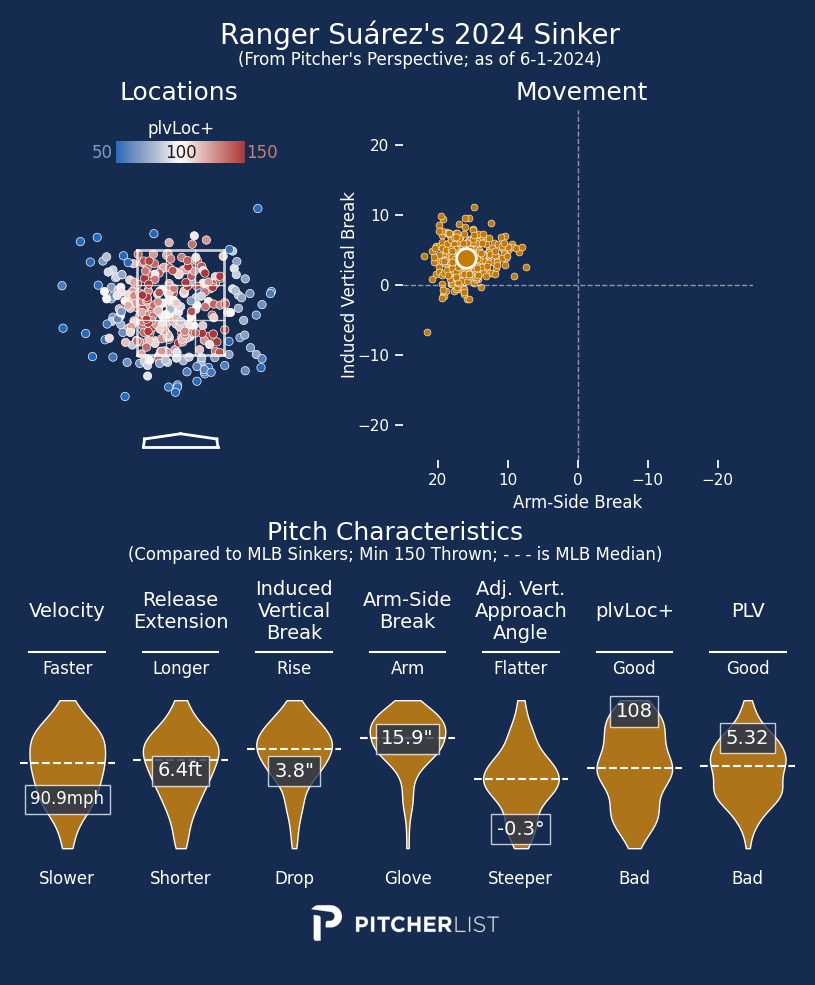
This is all even more impressive when you consider that he throws his Sinker in 2-Strike counts often (26.8 2-Str%; 79th percentile), so those called strikes return a lot of strikeouts looking (28.6% Put Away Rate; 86th percentile). Fold in positive contact suppression and you have a very effective pitch, even if it’s a fastball under 91 mph.
Changeup – Michael Wacha
I love all of my data viz children, but Wacha’s “waterfall” movement plot is one that always brings a smile to my face.
This pitch has range. He throws it with vert, where it could be a faux Sinker. He can take a ton of IVB off to create a Splitter profile. Or he can simply throw it like a standard Changeup. All of that in addition to his ability to spot it impeccably. It’s no wonder it’s his most used pitch: it’s the Swiss Army Knife of movement profiles, with a tool for every job.
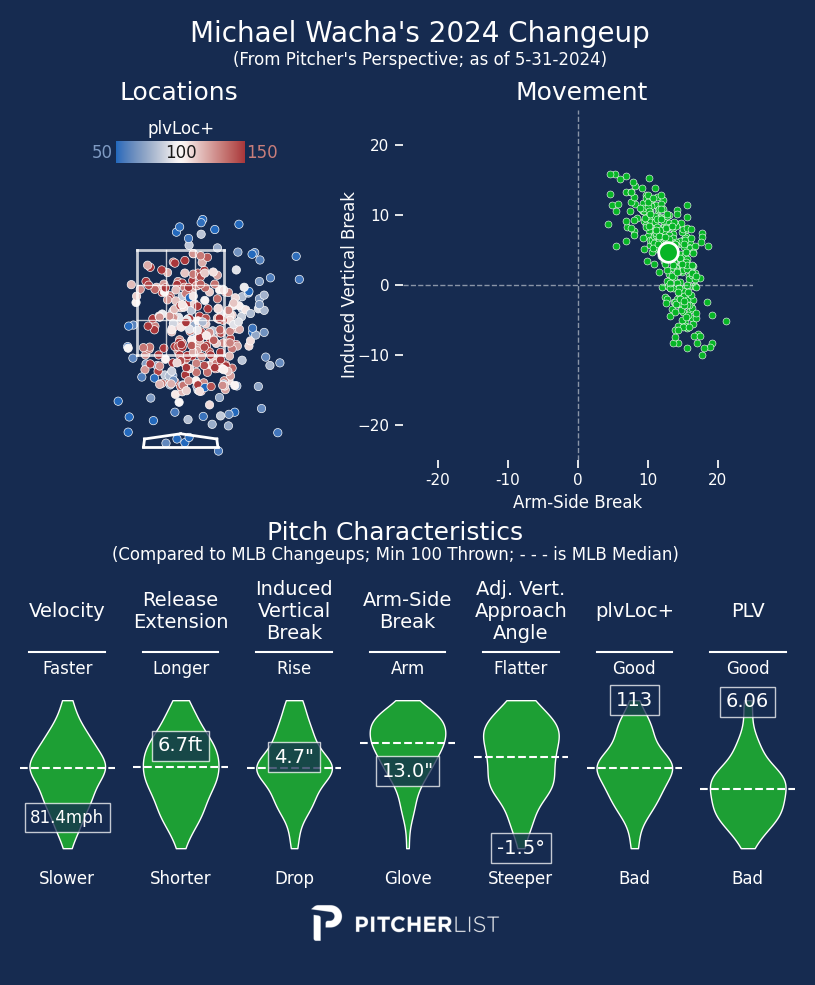
The pitch is great at earning strikes (29.9 CSW%; 82nd percentile) and is decent at limiting hard contact (.375 xwOBACON; 43rd percentile). Despite its 32% usage, Wacha doesn’t use the Changeup early in counts (41.6 Early%; 4th percentile), though he more than makes up for it with his heavy 2-Strike approach (45.2 2-Str%; 91st percentile). That usage and his high CSW marks combine to give him plenty of chances to earn strikeouts with the pitch, which he capitalizes on at a high rate (24.0% Put Away Rate; 80th percentile).
Curveball – Aaron Nola
I love a huge, looping breaker, and the Curveball from Nola is exactly that. It gets average drop (12.2″; 51st percentile) and a lot of sweep (13.8″; 86th percentile), which add up to a lot of movement (18.5″ total; 66th percentile) in two planes.
This is especially effective for Nola, since he has two fastballs he can throw, and his Curveball compliments them both. Fold in his ability to locate the pitch down and/or around the edges of the strike zone, and you have a deadly combination.
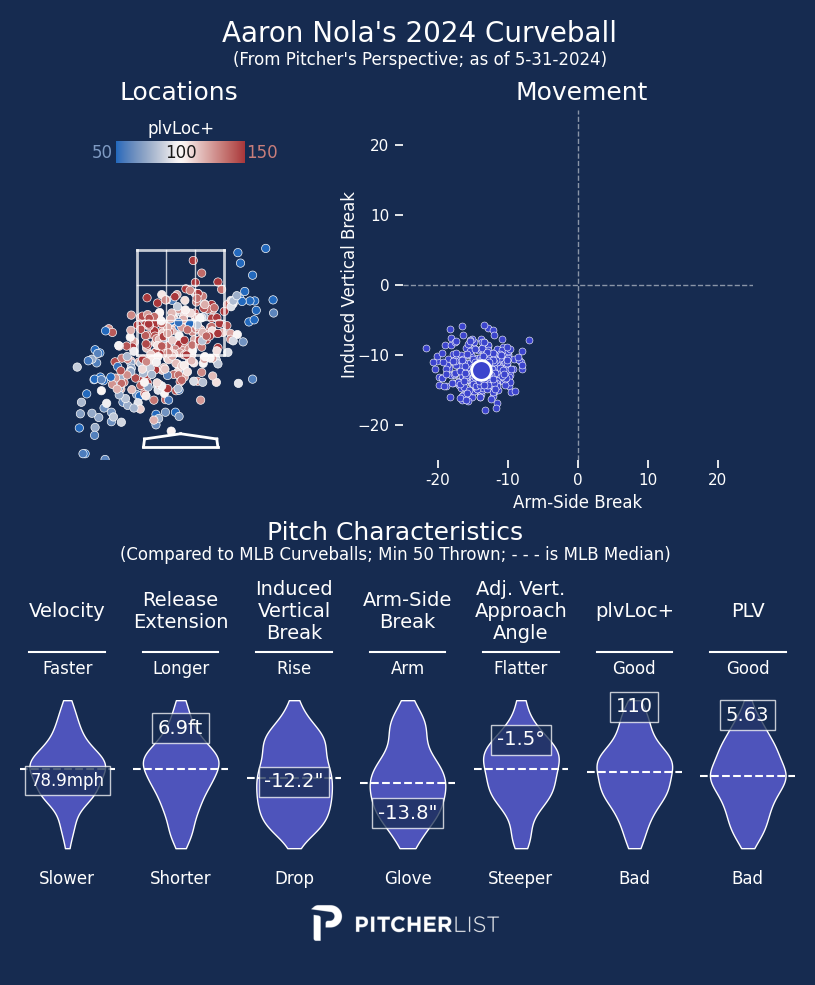
Nola’s elite plvLocation+ for the pitch illustrates why you can’t simply go by Zone% (41.4%; 55th percentile) when judging how a pitcher locates. Nola lives in the Shadow and Chase zones with his Curveball, which yields a mediocre Called Strike% (33rd percentile) but an elite SwStr% (87th percentile).
Put it all together, and the pitch has an absolutely elite PLUS% (67.5%; 96th percentile), which measures how often a pitch yields a positive event for a pitcher (CSW + Fouls + Field Outs). Nola’s Curveball truly does it all, which is why he’s one of the only starters with a Curveball as their most used pitch.
Cutter – Bailey Ober
Ah yes, Nick’s favorite pitch to tell pitchers to add: the Cutter. Is it a fastball, or is it a breaking ball? The answer… is it’s both.
PLV tends to favor Cutters that are used more as breaking balls since those are generally used in higher leverage counts, where they can do more damage. Ober manages to utilize his Cutter for the best of both worlds: it is very good at getting early outs (23.0 Early BIP%; 83rd percentile), while he also uses it frequently in 2-Strike counts (27.0%; 76th percentile). The Put Away Rate has some room for improvement (15.9%; 40th percentile), but the Cutter otherwise has a decent CSW% (53rd percentile).
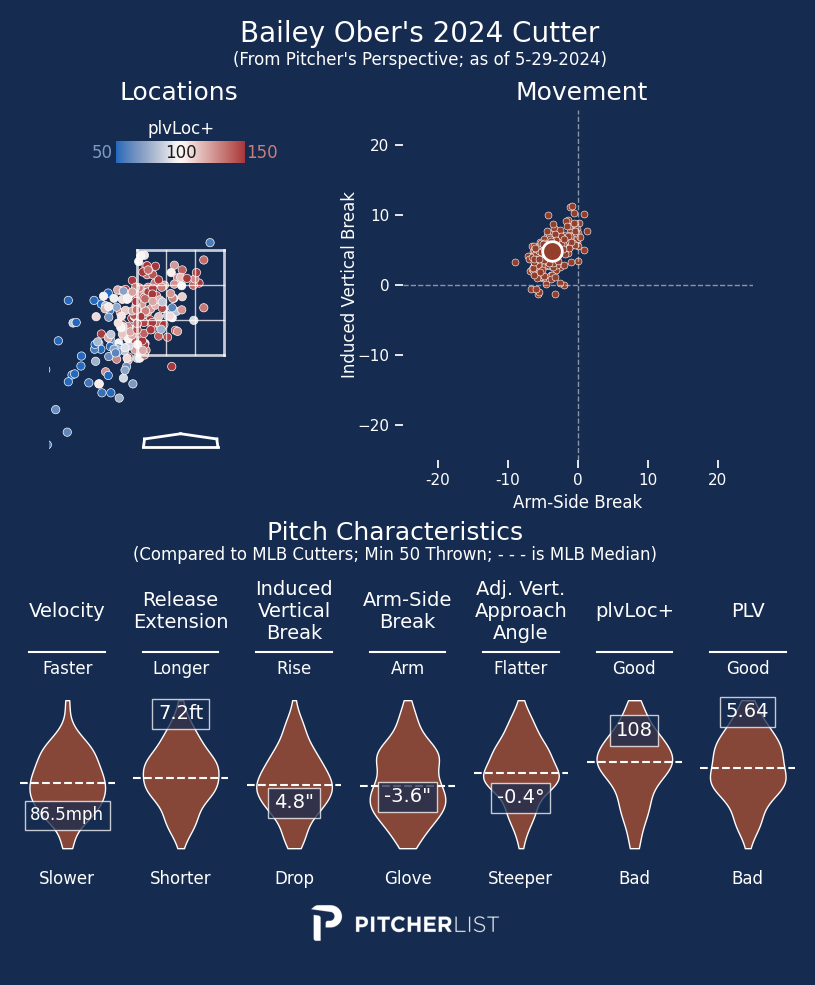
Where the pitch shines is how it combines that Early BIP% with weak contact. His ability to repeatedly hammer the glove-side edge of the strike zone (85.4 gLoc%; 97th percentile) results in tons of Fouls (23.2 FoulStr%) and yields a useful .350 xwOBACON (62nd percentile) when the contact ends up in play. The versatility of Ober’s Cutter has been a boon for him this season, even while some of his other pitches have let him down (looking at you, Four-Seamer, with your ghastly .566 xwOBACON).
Sweeper – Spencer Turnbull
The trendiest pitch of 2023 (with a Barbie-approved pink color, no less) has taken the league by storm and is showing no signs of stopping in its sophomore year as an official pitch type. With most of the pitch’s hype from last year behind us, no version of the pitch has swept me off of my feet more than Turnbull’s Sweeper. It’s a fascinating pitch because it’s a rising breaking pitch (4.2″; nearly as much as his Sinker’s 5.0″ of IVB!) due to Turnbull’s low arm slot. That unique movement helps turn his average horizontal break into something interesting and, more importantly, useful.
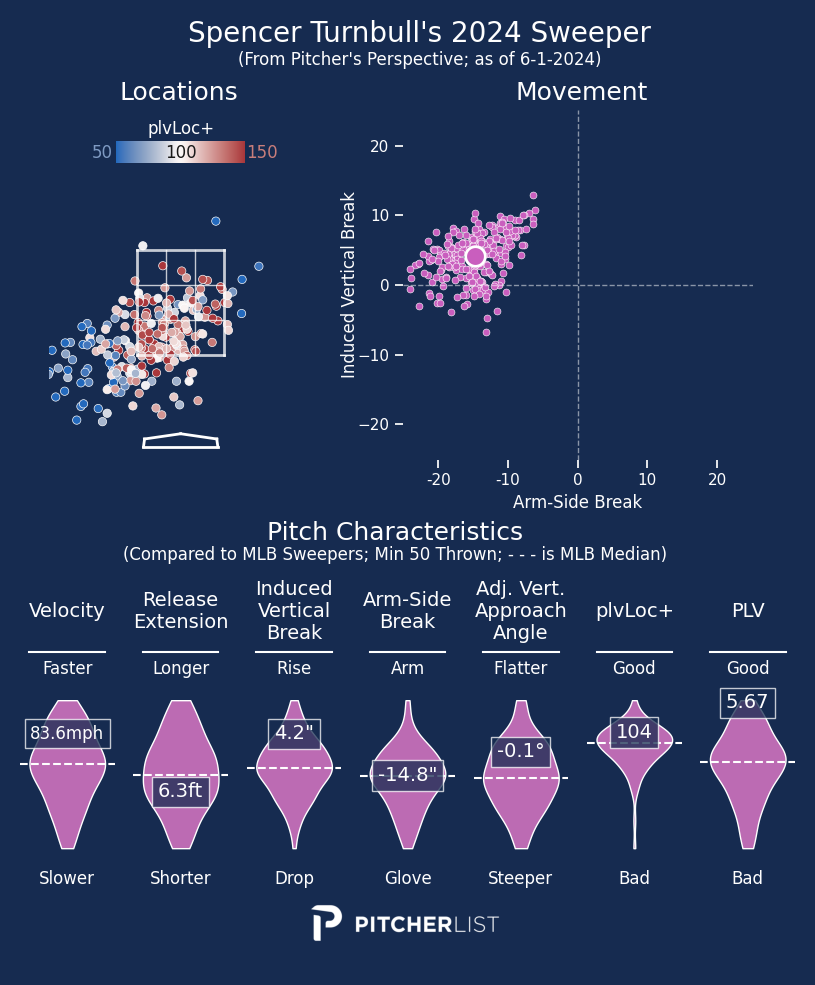
Turnbull does a solid job of keeping the pitch in and around the zone (104 plvLocation+), thanks primarily to keeping the pitch down (3.3 hiLoc%; 4th percentile). That unique movement, when paired with his low locations, has yielded a variety of benefits for Turnbull, with the most impactful being a very good CStr% (22.4%; 90th percentile) and very weak batted ball quality (.339 xwOBACON; 85th percentile). Those are the two ideal outcomes for a Sweeper and have resulted in Turnbull’s impressive rebound from a horrific 2023.
Splitter – Yoshinobu Yamamoto
I’ve heard that we’re in the Year of the Splitter, though rumors of increased usage have been exaggerated (Splitters are still only 3.2% of pitches thrown).
When looking at Yamamoto’s Splitter, it’s easy to see the benefits of the pitch type (and also some of the pitfalls). Yamamoto’s Splitter is hard, coming in faster than some 4-Seam Fastballs. That’s some impressive velocity on what is essentially an off-speed pitch.
The pitch will rarely, if ever, earn called strikes (33rd percentile), but that isn’t a feature of Splitters, especially ones used in 2-Strike counts as often as Yamamoto uses his (51.1 2-Str%; 81st percentile). This is a pitch that is more than the sum of its parts, and Yamamoto is using it to great success this season.
Knuckleball – Matt Waldron
It’s a knuckleball. It’s weird. Embrace the chaos.
Matt Waldron's Knuckleball may be Hazardous to your Health. 💀☠️⚰️ pic.twitter.com/sn8pTDfpbS
— Rob Friedman (@PitchingNinja) March 19, 2024
Photo by Rich Graessle/Icon Sportswire | Featured Image by Ethan Kaplan (@DJFreddie10 on Twitter and @EthanMKaplanImages on Instagram)

